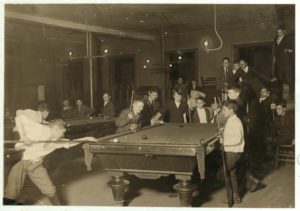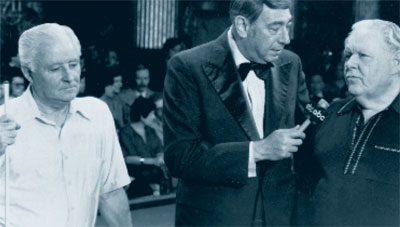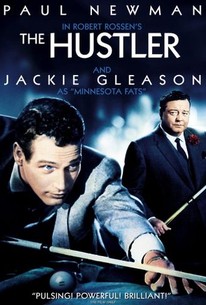 A Short History of American Pool
A Short History of American Pool
Pocket billiards can be traced back at least to the 1500s and probably began with European aristocracy. From there it quickly spread to public rooms and the working class. It wasn’t long
Jerome Keogh invented straight pool (also known as 14.1 continuous) in 1910 and it then became the official tournament game of pool in 1912. Some of pool’s greatest champions — men like Willie Mosconi and Ralph Greenleaf — specialized in this variation of the game. Hustlers like Wimpy Lassiter, Jersey Red
The sport declined in popularity during the 1950s but the release of the 20th Century Fox film, The Hustler, reinvigorated it
Pool historically has been a

With Willie Mosconi looking on, pool hustler Minnesota Fats speaks with ABC broadcaster Howard Cosell just prior to the “Great Shoot-Out” of 1978. The Mosconi-Fats match had televised ratings outstripping World Series games and it now stands as the most-watched pool competition in U.S. history. The Great Shoot-Out also solidified the life-long rivalry between the two players.
An American Pool History Timeline
1565
Pool makes its first appearance in North America, according to Frank G. Menke, a sports historian. A Spanish family brought it with them to St. Augustine, Florida. (Source: Life Magazine, Oct. 8, 1951).
1748
George Washington purported to have won a pool game. (Source: A Brief History of the Noble Game of Billiards, by Mike Shamos.)
1819
Michael Phelan, considered the father of American pool, is born in Castle Comer, County Kilkenny, Ireland.
1824
Michael Phelan and family join father John Phelan in New York City.
1827
The first slate tables appear. Previously, the playing surface of tables was cut from wood and then briefly with marble. However, marble was known to “sweat” in warm weather. [Source: Encyclopedia of Sports, by Frank G. Menke, 1939.]
1835
India rubber cushions are substituted for wooden cushions, which had been popular previously. The India rubber cushions provided a “spectacular bounce,” according to sports historian Frank G. Menke. [Source: Encyclopedia of Sports, by Frank G. Menke, 1939.]
1850
Phelan, seen now as greatest player in the United States, publishes Billiards Without a Master.
1856
Phelan’s book, Game of Billiards, is published; he opens a room at the corner of Broadway and 10th, New York. It was considered the finest and most luxurious pool room in the world. He also publishes the first edition of Billiard Cue, the first billiard periodical.
1859
Jim Seereiter and Michael Phelan play in a four-day standing room only tournament in Detroit for an astronomical $15,000. Phelan won; in April Dudley Kavanaugh beats Michael Foley in another high-profile match, also in Detroit.
1863
Phelan retires from active competition; he also offers a $10,000 reward for anyone who can devise a suitable ivory substitute for the manufacturer of billiard balls. This effort has been credited with the development of plastic.
Dudley Kavanagh wins in a pro championship in Irving Hall, New York, June 1-9. He becomes second U.S. pool champion.
1865
Vulcanized rubber came into use for cushions, and remains the standard to this day. [Source: Encyclopedia of Sports, by Frank G. Menke, 1939.]
1865
On Sept. 7, Louis Fox and John Deery, joint holders of the world billiards championship of 1864, meet in Washington Hall, Rochester, New York, to decide the 1865 title. According to an account of sports historian Menke: “Fox, far in the lead and on his way to winning, found himself bothered by a fly, which, despite ‘shooing,’ continued to light on the cue ball. Fox, excitingly trying to chase the fly, miscued, and it was Deery’s shot. Deery ran out the string to win the championship. The heart broken Fox rushed out of the hall to a river, leaped in, and was drowned.” [Source: Encyclopedia of Sports, by Frank G. Menke, 1939.]
1869
Celluloid, the first industrial plastic, is discovered by New Yorker John Wesley Hyatt. Hyatt was attempting to come up with a substitute for ivory billiard balls, but his new substitutes sometimes exploded on impact.
1873
Jerome Keogh, inventor of straight pool and five-times billiard champion, is born.
1897
Keogh wins his first world championship.
1907
Eight ball is invented. The first three-cushion championship is established.
1910
The game of straight pool is invented by Jerome Keogh.
1911
The very first World 14.1 Tournament was held in 1911 and won by Alfredo De Oro.
1912
Straight pool becomes the official tournament game of pocket billiards.
1913
Rudolf Wanderone, AKA Minnesota Fats, is born in New York on Jan. 13. Willie Mosconi is born in Philadelphia on June 27. The industry reports one of its best years, ever, for table sales.
1916
Ralph Greenleaf competes in his first national championship tournament, held in October at Doyle’s Academy in New York. The 16-year-old Greenleaf was described as a “Boy Wonder” by the New York Times.
1918
Luther Lassiter is born.
1919
Greenleaf wins the first of his 13 world titles.
1929
Greenleaf, playing in Detroit, regains the title – his eighth. He defeats the scoreless Frank Taberski with a sensational 126-ball run.
1929
Harold Worst, future three-cushion and pool champion, is born on Sept. 29 in Grand Rapids, Michigan.
1933
Willie Mosconi makes his national tournament debut.
1941
Willie Mosconi wins the first of 15 world titles.
1948
The Billiard Congress of America is established.
1953
Jerome Keogh, winner of five titles and the inventor of straight pool, dies at age 80 on January 12.
1954
Harold Worst wins the world three-cushion title during an event held in Buenos Aires, Argentina.
1954
Willie Mosconi establishes the BCA-recognized straight-pool high-run record of 526 balls. He accomplished the startling feat in Ohio, on an 8 by 4 table.
1956
Willie Mosconi suffers a stroke.

1961
George Jansco conducts the first of his famous hustler tournaments in Johnston City, Illinois. The tournaments, which lasted about a decade, would eventually attract nationwide attention.
20th Century Fox releases “The Hustler.” The film, starring Jackie Gleason and Paul Newman, would reinvigorate the public’s interest in the sport.
Rudolf Wanderone begins making the fanciful claim that he was the real-life inspiration for the film’s Minnesota Fats character.
1963
Luther Lassiter wins the first of his seven Billiard Congress of America-recognized titles. He won many more non-sanctioned events.
1964
Pool players and civil rights activists picket outside the Commodore Hotel in New York City to protest the exclusion of African American player Cisero Murphy from that year’s championship tournament, sponsored by the Billiard Room Proprietors Association of America.
1965
Three-cushion champ Harold Worst briefly conquers the world of pocket billiards with victories at the Las Vegas Stardust tournament in June, and in Johnston City in October and November.
African American player Cisero Murphy breaks the color barrier at the top level of American professional pool by winning 14 matches in a row to capture the World Invitational 14.1 Tournament. He won the California event in his first attempt.
1966
The Bank Shot and Other Great Robberies, the fanciful memoirs written by Minnesota Fats and Philadelphia newspaper writer Tom Fox, gets published.
1969
George Jansco dies. Brother Paulie takes over management of Johnston City tournament.
1972
After reading newspaper reports of widespread gambling, federal agents on Oct. 26 raid the Johnston City tournament. The ’72 tournament would be the last.
1978
Willie Mosconi and Minnesota Fats would play the first of several televised challenge matches. It was the most-viewed pool match in U.S. history.
1984
Earl Strickland wins the first of his historic five U.S. Opens.
1986
The Color of Money, a sequel to The Hustler, opens to favorable reviews. The film stars Tom Cruise with Paul Newman reprising his role as Fast Eddy Felson.
1993
Willie Mosconi dies in Haddon Heights, New Jersey on Sept. 16.
1995
Allison Fisher wins the first of her more than 50 Women’s Professional Billiard Association titles.
1996
Minnesota Fats dies on Jan. 18.
2000 – 2001
Allison Fisher wins 8 consecutive major pro pool tournaments.
2007
Shane Van Boening wins the first of his five U.S. Opens.
2019
On May 27, John Schmidt runs 626 balls at straight pool, officially breaking Willie Mosconi’s 1954 record. Schmidt played successive games over weeks in the attempt.